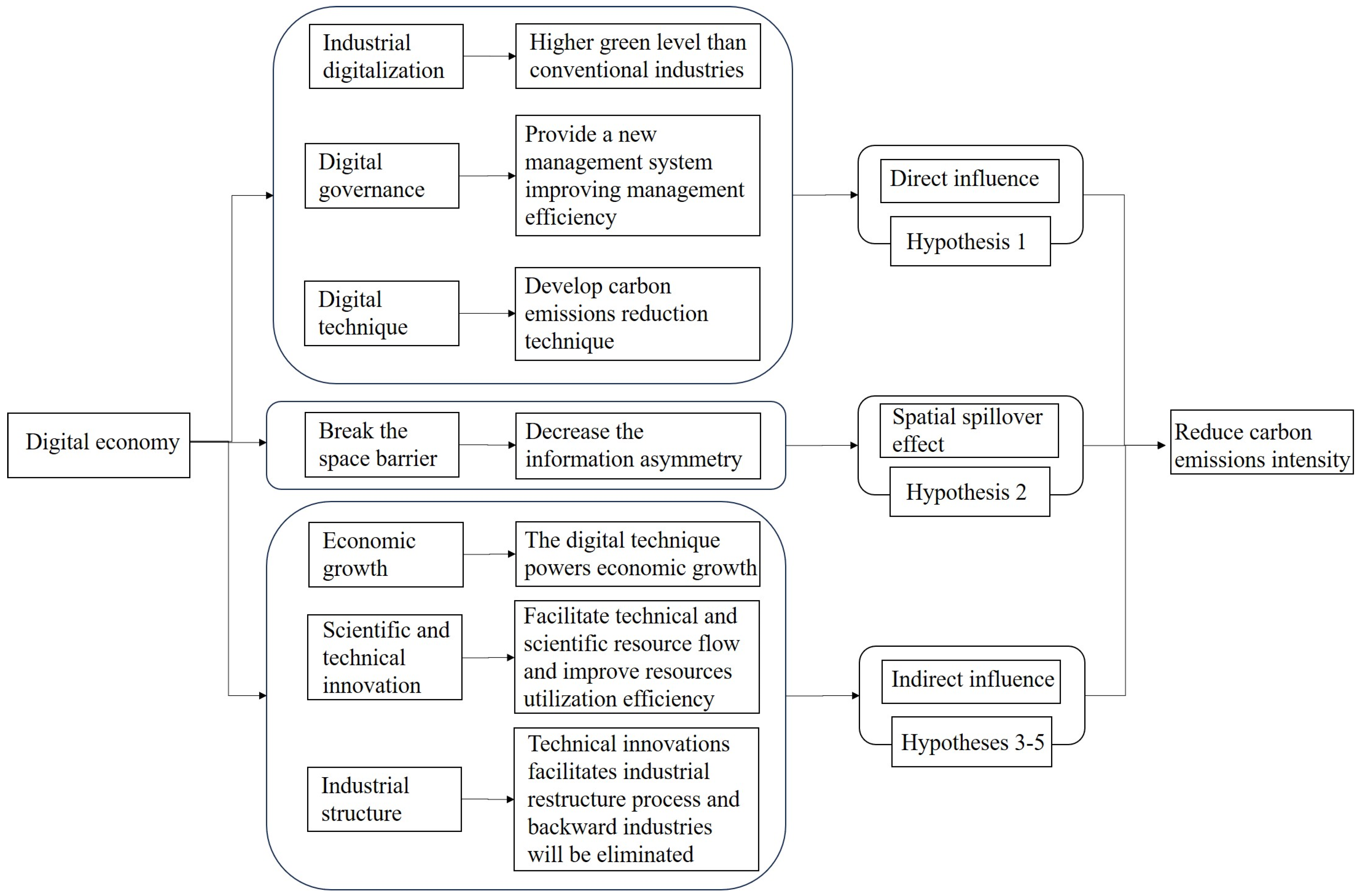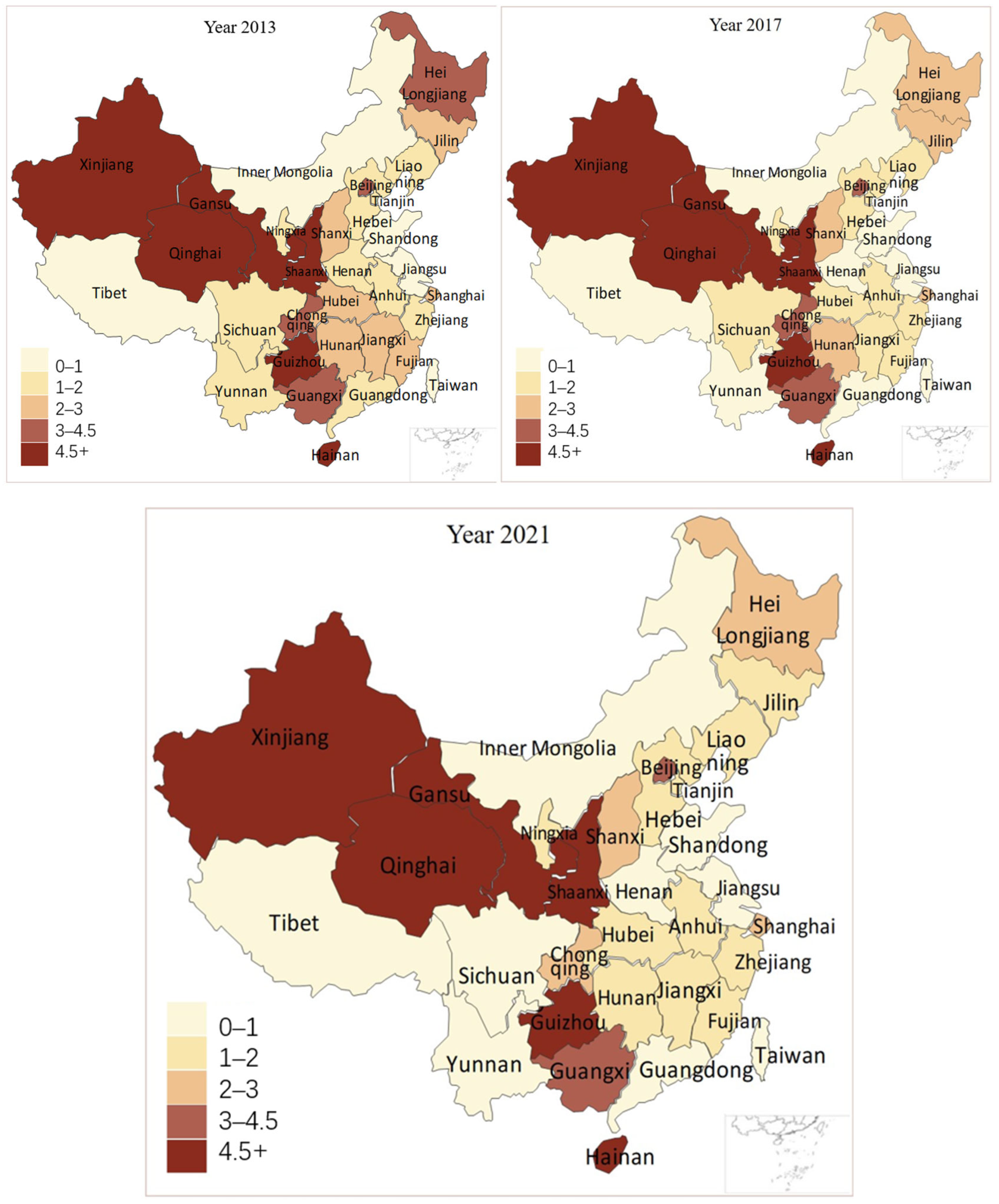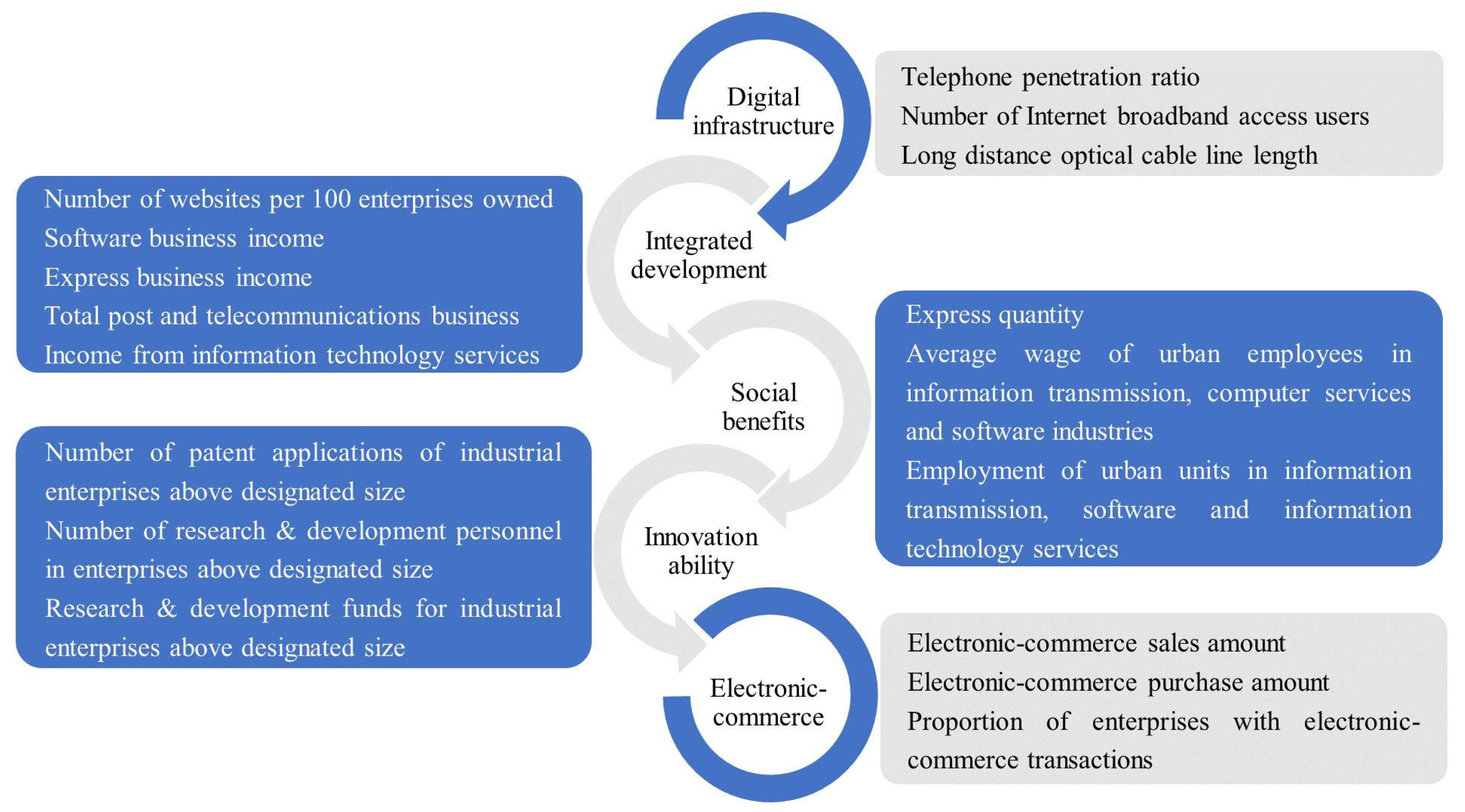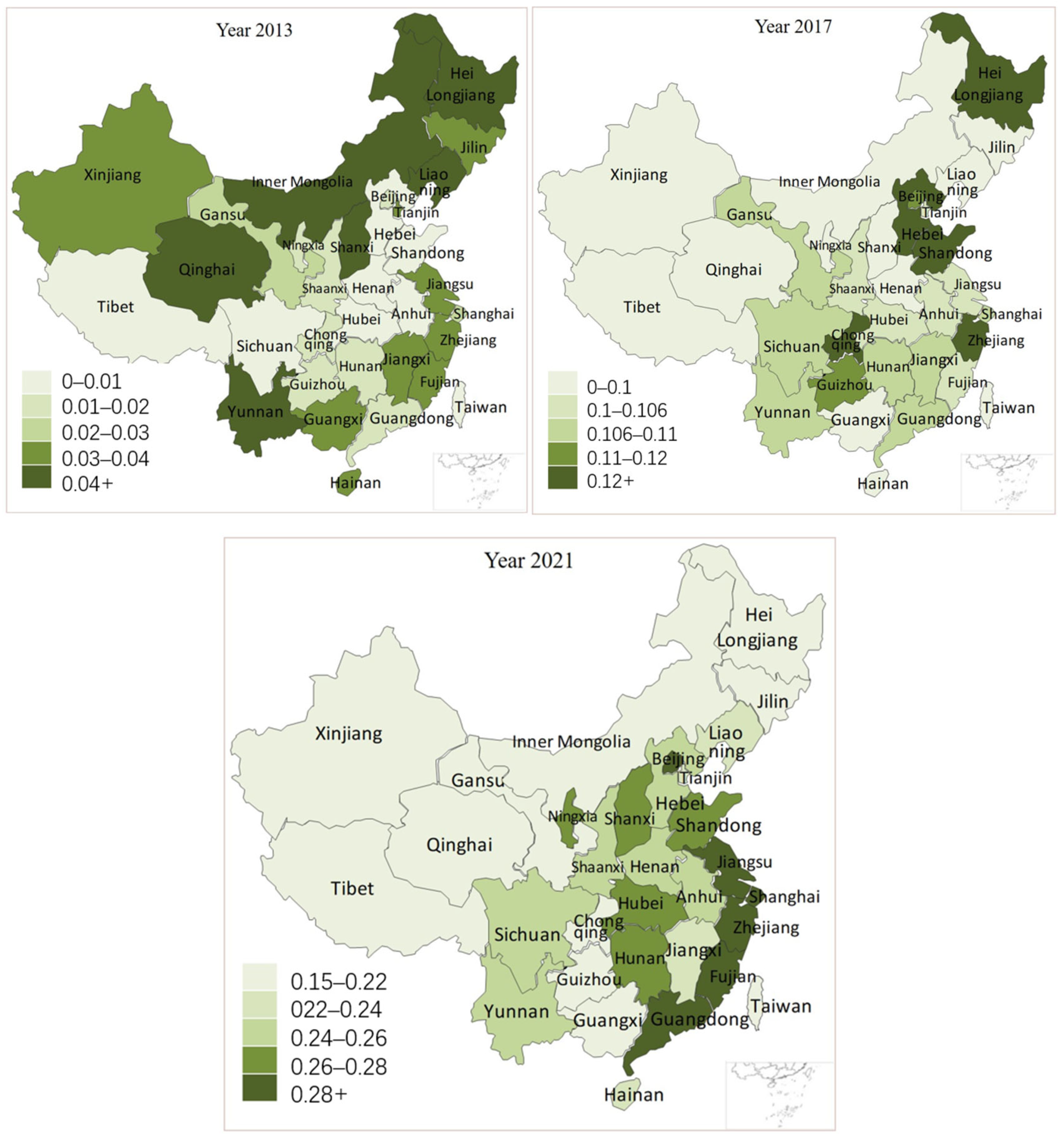The Influence Mechanism of the Digital Economy on Carbon Intensity Across Chinese Provinces
Abstract
1. Introduction
2. Literature Review
3. Theoretical Mechanism and Hypotheses
3.1. The Direct Influence of the DE on CEs Reduction
3.2. Spatial Spillover Effect of the DE on CEs Reduction
3.3. The Mechanisms Associated with the Influence of the DE on CEs
4. Methodology, Variables, and Data Sources
4.1. Model Setting
4.1.1. Basic Regression Model
4.1.2. Mediating Effect Model
4.1.3. Spatial Autocorrelation Test Model
4.1.4. Spatial Econometrics
4.2. Variables Selection and Data Sources
4.2.1. Dependent Variable
4.2.2. Explanatory Variable
4.2.3. Mediating Variables
4.2.4. Control Variables
5. Results and Discussion
5.1. Benchmark Regression Analysis
5.2. Analysis of Spatial Spillover Effects
5.3. Analysis of Mediation Effect Regression Results
5.4. Regional Heterogeneity Discussion
5.5. Robustness Test
5.6. Endogenous Processing
6. Conclusions and Policy Implications
6.1. Conclusions
6.2. Policy Implications
Author Contributions
Funding
Institutional Review Board Statement
Informed Consent Statement
Data Availability Statement
Conflicts of Interest
References
- Sun, J.; Chen, J. Digital Economy, Energy Structure Transformation, and Regional Carbon Dioxide Emissions. Sustainability 2023, 15, 8557. [Google Scholar] [CrossRef]
- Li, X.; Liu, J.; Ni, P. The Impact of the Digital Economy on CO2 Emissions: A Theoretical and Empirical Analysis. Sustainability 2021, 13, 7267. [Google Scholar] [CrossRef]
- Sun, J.; Dong, F. Decomposition of carbon emission reduction efficiency and potential for clean energy power: Evidence from 58 countries. J. Clean. Prod. 2022, 363, 132312. [Google Scholar] [CrossRef]
- Zheng, J.; Wang, X. Can mobile information communication technologies (ICTs) promote the development of renewables?—Evidence from seven countries. Energy Pol. 2021, 149, 112041. [Google Scholar] [CrossRef]
- The Digital China Development Report (2022); National Internet Information Office: Beijing, China, 2023.
- Zhang, Y.; Yu, Z.; Zhang, J. Analysis of carbon emission performance and regional differences in China’s eight economic regions: Based on the super-efficiency SBM model and the Theil index. PLoS ONE 2021, 16, 0250994. [Google Scholar] [CrossRef] [PubMed]
- Sun, W.; Huang, C. How does urbanization affect carbon emission efficiency? Evidence from China. J. Clean. Prod. 2020, 272, 122828. [Google Scholar] [CrossRef]
- Yu, Y.; Zhang, N. Low-carbon city pilot and carbon emission efficiency: Quasi experimental evidence from China. Energy Econ. 2020, 96, 105125. [Google Scholar] [CrossRef]
- Weina, D.; Gilli, M.; Mazzanti, M.; Nicolli, F. Green inventions and greenhouse gas emission dynamics: A close examination of provincial Italian data. Environ. Econ. Pol. Stud. 2016, 18, 247–263. [Google Scholar] [CrossRef]
- Wang, Z.H.; Yin, F.C.; Zhang, Y.X.; Zhang, X. An empirical research on the influencing factors of regional CO2 emissions: Evidence from Beijing city, China. Appl. Energy 2012, 100, 277–284. [Google Scholar] [CrossRef]
- Geels, F.W.; Sovacool, B.K.; Schwanen, T.; Sorrell, S. Sociotechnical transitions for deep decarbonization accelerating innovation is as important as climate policy. Science 2017, 357, 1242–1244. [Google Scholar] [CrossRef]
- Dumont, B.; Groot, J.C.J.; Tichit, M. Review: Make ruminants green again—How can sustainable intensification and agroecology converge for a better future? Animal 2018, 12, 210–219. [Google Scholar] [CrossRef] [PubMed]
- Frenken, K.; Schor, J. Putting the sharing economy into perspective. Environ. Innov. Soc. Transit. 2017, 23, 3–10. [Google Scholar] [CrossRef]
- Tapscott, D. The Digital Economy: Promise and Peril in the Age of Networked Intelligence; McGraw-Hill: New York, NY, USA, 1996. [Google Scholar]
- China Academy of Information and Communication Research (CAICR). White Paper on the Development of China’s Digital Economy; CAICR: Beijing, China, 2020. (In Chinese) [Google Scholar]
- Bukht, R.; Heeks, R. Defining, conceptualising and measuring the digital economy development informatics. SSRN Electron. J. 2017, 13, 143–172. [Google Scholar]
- Zhang, W.; Liu, X.M.; Wang, D.; Zhou, J.P. Digital economy and carbon emission performance: Evidence at China’s city level. Energy Pol. 2022, 165, 112927. [Google Scholar] [CrossRef]
- Xu, X.C.; Zhang, M.H. Research on the scale measurement of China’s digital economy—Based on the perspective of international comparison. China Ind. Econ. 2020, 5, 23–41. [Google Scholar]
- Zhao, H.; Guo, S. A hybrid MCDM model combining Fuzzy-Delphi, AEW, BWM, and MARCOS for digital economy development comprehensive evaluation of 31 provincial level regions in China. PLoS ONE 2023, 18, e0283655. [Google Scholar] [CrossRef]
- Zhao, H.; Guo, S. Analysis of the non-linear impact of digital economy development on energy intensity: Empirical research based on the PSTR model. Energy 2023, 282, 128867. [Google Scholar] [CrossRef]
- Chen, L.; Lu, Y.; Meng, Y.; Zhao, W. Research on the nexus between the digital economy and carbon emissions-Evidence at China’s province level. J. Cleaner Prod. 2023, 413, 137484. [Google Scholar] [CrossRef]
- Haseeb, A.; Xia, E.; Saud, S.; Ahmad, A.; Khurshid, H. Does information and communication technologies improve environmental quality in the era of globalization? An empirical analysis. Environ. Sci. Pollut. Res. 2019, 26, 8594–8608. [Google Scholar] [CrossRef]
- Dong, F.; Hu, M.; Gao, Y.; Liu, Y.; Zhu, J.; Pan, Y. How does digital economy affect carbon emissions? Evidence from global 60 countries. Sci. Total Environ. 2022, 852, 158401. [Google Scholar] [CrossRef]
- Yi, M.; Liu, Y.; Sheng, M.S.; Wen, L. Effects of digital economy on carbon emission reduction: New evidence from China. Energy Policy 2022, 171, 113271. [Google Scholar] [CrossRef]
- Zhou, X.; Zhou, D.; Wang, Q.; Su, B. How information and communication technology drives carbon emissions: A sector-level analysis for China. Energy Econ. 2019, 81, 380–392. [Google Scholar] [CrossRef]
- Salahuddin, M.; Alam, K. Information and Communication Technology electricity consumption and economic growth in OECD countries: A panel data analysis. Int. J. Electr. Power Energy Syst. 2016, 76, 185–193. [Google Scholar] [CrossRef]
- Sun, Y.W.; Hu, Z.H. Digital economy, industrial upgrading and improvement of urban environmental quality. Statist. Decis. 2021, 37, 91–95. (In Chinese) [Google Scholar]
- Ding, Y.L.; Zhang, Z.N.; Zhang, W.L. Empirical study on information and communication technology and technological innovation—Based on digital economy. J. North China Univ. Sci. Technol. (Soc. Sci. Ed.) 2022, 22, 22–26. (In Chinese) [Google Scholar]
- Ren, S.; Hao, Y.; Xu, L.; Wu, H.; Ba, N. Digitalization and energy: How does internet development affect China’s energy consumption? Energy Econ. 2021, 98, 105220. [Google Scholar] [CrossRef]
- Li, Z.G.; Wang, J. How does the digital economy affect spatial carbon emissions under economic agglomeration? J. Xi’an Jiao Tong Univ. (Soc. Sci.) 2022, 42, 1–16. (In Chinese) [Google Scholar]
- Yilmaz, S.; Haynes, K.E.; Dinc, M. Geographic and network neighbors: Spillover effects of telecommunications infrastructure. J. Reg. Sci. 2002, 42, 339–360. [Google Scholar] [CrossRef]
- Liu, Q.; Wu, S.; Lei, Y.; Li, S.; Li, L. Exploring spatial characteristics of city-level CO2 emissions in China and their influencing factors from global and local perspectives. Sci. Total Environ. 2021, 754, 142206. [Google Scholar] [CrossRef]
- Godwin, M.; Mehmet, K.; Justus, H. Determinants of digitalization and digital divide in Sub-Saharan African economies: A spatial Durbin analysis. Telecommun. Pol. 2021, 45, 102224. [Google Scholar]
- Xu, Q.; Zhong, M.; Cao, M. Does digital investment affect carbon efficiency? Spatial effect and mechanism discussion. Sci. Total Environ. 2022, 827, 154321. [Google Scholar] [CrossRef] [PubMed]
- Kenny, C. The internet and economic growth in less-developed countries: A case of managing expectations? Oxf. Dev. Stud. 2003, 31, 99–113. [Google Scholar] [CrossRef]
- Zhu, H.L.; Wang, C.J. Digital economy leads high-quality development of industry: Theory, mechanism and path. Theory Pract. Financ. Econ. 2020, 41, 2–10. (In Chinese) [Google Scholar]
- Qin, J.; Liu, Y.; Grosvenor, R. Data analytics for energy consumption of digital manufacturing systems using Internet of Things method. In Proceedings of the 2017 13th IEEE Conference on Automation Science and Engineering (CASE), Xi’an, China, 20–23 August 2017; pp. 482–487. [Google Scholar]
- Vassileva, I.; Wallin, F.; Dahlquist, E. Understanding energy consumption behavior for future demand response strategy development. Energy 2012, 46, 94–100. [Google Scholar] [CrossRef]
- Wen, Z.; Zhang, L. The Test Procedure and Its Application of Mediating Effect. Acta Psychol. Sin. 2004, 36, 614–620. [Google Scholar]
- Zhao, F.; Luo, L. The impact of industrial agglomeration on urban carbon emissions in the Yangtze River economic belt: Heterogeneity and action mechanism. Reform 2022, 35, 68–84. [Google Scholar]
- Wu, J.; Guo, Z. Research on the convergence of carbon dioxide emissions in China: A continuous dynamic distribution approach. Stat. Res. 2016, 33, 54–60. [Google Scholar]
- Li, Z.; Wang, J. The dynamic impact of digital economy on carbon emission reduction: Evidence city-level empirical data in China. J. Clean. Prod. 2022, 351, 131570. [Google Scholar] [CrossRef]
- Zhu, W.J.; Chen, J.J. The Spatial Analysis of Digital Economy and Urban Development: A Case Study in Hangzhou, China. Cities 2022, 123, 103563. [Google Scholar] [CrossRef]
- Ding, C.; Liu, C.; Zheng, C.; Li, F. Digital economy, technological innovation and high-quality economic development: Based on spatial effect and mediation effect. Sustainability 2022, 14, 216. [Google Scholar] [CrossRef]
- Xue, Y.; Tang, C.; Wu, H.T.; Liu, J.M.; Hao, Y. The emerging driving force of energy consumption in China: Does digital economy development matter? Energy Pol. 2022, 165, 112997. [Google Scholar] [CrossRef]
- Gao, D.; Li, G.; Yu, J. Does digitization improve green total factor energy efficiency? Evidence from Chinese 213 cities. Energy 2022, 247, 123395. [Google Scholar] [CrossRef]
- Yu, B.; Fang, D.; Yu, H.; Zhao, C. Temporal-spatial determinants of renewable energy penetration in electricity production: Evidence from EU countries. Renew. Energy 2021, 180, 438–451. [Google Scholar] [CrossRef]
- Yao, X.; Zhang, X.; Guo, Z. The tug of war between local government and enterprises in reducing China’s carbon dioxide emissions intensity. Sci. Total Environ. 2020, 710, 136140. [Google Scholar] [CrossRef] [PubMed]
- Sun, Y.; Li, H.; Andlib, Z.; Genie, M.G. How do renewable energy and urbanization cause carbon emissions? Evidence from advanced panel estimation techniques. Renew. Energ. 2022, 185, 996–1005. [Google Scholar] [CrossRef]
- Pace, R.K.; Lesage, J.P. A sampling approach to estimate the log determinant used in spatial likelihood problems. J. Geogr. Syst. 2009, 11, 209–225. [Google Scholar] [CrossRef]
- Baron, R.M.; Kenny, D.A. The moderator-mediator variable distinction in social psychological research: Conceptual, strategic, and statistical considerations. J. Personal. Soc. Psychol. 1999, 51, 1173. [Google Scholar] [CrossRef]
- Preacher, K.J.; Hayes, A.F. SPSS and SAS procedures for estimating indirect effects in simple mediation models. Behav. Res. Methods Instrum. Comput. 2004, 36, 717–731. [Google Scholar] [CrossRef]
- Huang, Q.; Yu, Y.; Zhang, S. Internet development and productivity growth in manufacturing industry: Internal mechanism and China experiences. China Ind. Econ. 2019, 8, 5–23. [Google Scholar]
- Nunn, N.; Qian, N. US food aid and civil conflict. Am. Econ. Rev. 2014, 104, 1630–1666. [Google Scholar] [CrossRef]




| Variable | Unit | Mean | Std. Dev. | Min | Max |
|---|---|---|---|---|---|
| CEI | CNY 1 million/100 tons | 3.9592 | 5.3929 | 0.5855 | 31.4710 |
| DE | - | 0.1276 | 0.0823 | 0.0016 | 0.4720 |
| Real GDP | CNY 1 trillion | 1.8780 | 1.5416 | 0.0535 | 7.7743 |
| STI | 105 terms | 1.1898 | 1.6123 | 0.0110 | 9.8063 |
| IS | % | 1.3745 | 0.7429 | 0.6601 | 5.2332 |
| ES | % | 0.9183 | 0.4837 | 0.0132 | 2.5184 |
| GOV | % | 0.0220 | 0.0151 | 0.0054 | 0.0676 |
| TRD | % | 0.2529 | 0.2639 | 0.0076 | 1.3418 |
| UR | % | 0.6088 | 0.1146 | 0.3789 | 0.8960 |
| ER | % | 0.3485 | 0.1839 | 0.0424 | 0.6680 |
| Variables | Y = CEI | Y = CEI | Y = CEI | Y = CEI |
|---|---|---|---|---|
| DE | −12.809 *** | −13.262 *** | −14.901 *** | −14.632 *** |
| (−6.681) | (−6.786) | (−6.113) | (−5.924) | |
| ES | 3.005 * | 3.013 * | 3.026 * | |
| (−3.308) | (−4.201) | (−4.373) | ||
| GOV | −4.301 * | −5.275 * | −5.547 * | |
| (−3.878) | (−4.010) | (−4.132) | ||
| TRD | −1.012 | −0.098 | ||
| (−1.201) | (−1.155) | |||
| UR | 5.687 ** | 4.388 ** | ||
| (4.376) | (4.002) | |||
| ER | −1.153 * | |||
| (3.851) | ||||
| Constant | 9.105 *** | 30.286 *** | 31.147 *** | 31.645 *** |
| (13.467) | (4.631) | (5.519) | (6.509) | |
| Year FE | YES | YES | YES | YES |
| Province FE | YES | YES | YES | YES |
| R-squared | 0.868 | 0.886 | 0.893 | 0.912 |
| Year | CEI | DE | ||
|---|---|---|---|---|
| MI | p-Value | MI | p-Value | |
| 2013 | 0.321 | 0.002 | 0.098 | 0.102 |
| 2014 | 0.357 | 0.001 | 0.132 | 0.090 |
| 2015 | 0.329 | 0.003 | 0.145 | 0.089 |
| 2016 | 0.332 | 0.004 | 0.146 | 0.083 |
| 2017 | 0.343 | 0.003 | 0.152 | 0.079 |
| 2018 | 0.326 | 0.003 | 0.143 | 0.072 |
| 2019 | 0.325 | 0.002 | 0.152 | 0.051 |
| 2020 | 0.318 | 0.003 | 0.161 | 0.044 |
| 2021 | 0.329 | 0.003 | 0.163 | 0.045 |
| 2022 | 0.327 | 0.002 | 0.158 | 0.044 |
| 2023 | 0.328 | 0.002 | 0.160 | 0.045 |
| Variables | Main | Wx | LR Direct | LR Indirect | LR Total |
|---|---|---|---|---|---|
| DE | −14.623 *** | 0.892 | −15.393 *** | 5.983 * | −9.305 *** |
| (−6.312) | (0.256) | (−6.837) | (1.895) | (−2.968) | |
| ES | 0.323 * | 0.531 * | 0.346 * | 0.312 * | 0.293 * |
| (−1.578) | (1.686) | (−1.672) | (−1.713) | (−1.689) | |
| GOV | −6.036 *** | −9.163 *** | −6.912 *** | −9.132 *** | −15.283 *** |
| (−3.897) | (−4.312) | (−4.493) | (−5.012) | (−6.334) | |
| TRD | −2.893 ** | −4.386 *** | −1.567 ** | −2.889 ** | −4.032 *** |
| (−2.931) | (−3.012) | (−2.991) | (−2.983) | (−3.245) | |
| UR | 0.343 * | 0.267 * | 0.361 * | 0.406 * | 0.372 * |
| (−2.875) | (−2.797) | (−2.838) | (−2.873) | (−2.779) | |
| ER | −0.096 * | 0.002 | −0.099 * | −0.089 * | −0.099 ** |
| (−2.901) | (0.015) | (−2.788) | (−2.989) | (−3.301) | |
| Year FE | YES | YES | YES | YES | YES |
| Province FE | YES | YES | YES | YES | YES |
| R-squared | 0.286 | 0.286 | 0.286 | 0.286 | 0.286 |
| Variables | Y = Real GDP | Y = STI | Y = IS | Y = CEI | Y = CEI | Y = CEI |
|---|---|---|---|---|---|---|
| DE | 0.497 *** | 0.512 *** | 0.301 * | −13.301 *** | −12.301 *** | −13.102 *** |
| (−3.416) | (−3.879) | (−2.979) | (−4.397) | (−4.998) | (−3.899) | |
| Real GDP | −3.697 | |||||
| (−1.901) | ||||||
| STI | −5.679 *** | |||||
| (−4.126) | ||||||
| IS | −2.012 ** | |||||
| (−2.991) | ||||||
| ES | 0.301 | −0.209 * | 0.309 * | 3.096 *** | 0.004 | 0.889 * |
| (0.802) | (−2.796) | (−2.836) | (−4.012) | (0.034) | (−2.913) | |
| GOV | 0.526 ** | 0.312 * | −0.687 * | −2.978 ** | −2.937 *** | −0.030 |
| (−3.034) | (−3.001) | (−2.999) | (−3.012) | (−5.012) | (1.003) | |
| TRD | 0.332 ** | 0.798 ** | 0.401 * | −1.089 * | 0.123 | −2.030 * |
| (−2.996) | (−3.112) | (−3.011) | (−2.869) | (1.053) | (−2.997) | |
| UR | 0.103 * | 0.112 | 0.208 * | 1.030 * | 0.302 | 2.012 * |
| (−2.578) | (0.859) | (−2.902) | (−2.997) | (0.879) | (−3.001) | |
| ER | −0.568 * | 0.373 | 0.102 | −2.301 * | 0.103 | 0.011 |
| (−2.779) | (0.105) | (1.034) | (−2.889) | (0.206) | (0.978) | |
| Constant | −0.968 * | 30.937 * | 15.337 ** | 6.887 * | 32.668 *** | 4.991 ** |
| (−2.999) | (−3.039) | (3.357) | (4.012) | (6.798) | (3.238) | |
| Year FE | YES | YES | YES | YES | YES | YES |
| Province FE | YES | YES | YES | YES | YES | YES |
| R-squared | 0.918 | 0.929 | 0.905 | 0.926 | 0.707 | 0.779 |
| Variables | Effects | Coefficient | z-Value | p-Value | Confidence Interval |
|---|---|---|---|---|---|
| Real GDP | Direct effect | −1.073 | −3.798 | 0.003 | (−1.55, −0.15) |
| Indirect effect | −0.937 | −4.036 | 0.000 | (−1.23, −0.20) | |
| STI | Direct effect | −2.373 | −2.968 | 0.041 | (−3.06,−0.18) |
| Indirect effect | −1.408 | −2.035 | 0.030 | (−2.04, −0.16) | |
| IS | Direct effect | −8.937 | −5.318 | 0.000 | (−9.55, −5.15) |
| Indirect effect | −3.012 | −4.386 | 0.000 | (−4.02, −1.18) |
| Variables | Eastern Area | Middle Area | Western Area | |||
|---|---|---|---|---|---|---|
| DE | −2.012 | −2.033 *** | −48.013 ** | −26.014 *** | −57.366 *** | −26.307 *** |
| (−1.083) | (−3.038) | (−3.351) | (−6.332) | (−6.782) | (−3.819) | |
| Wx | −7.036 *** | 36.281 | −80.683 *** | |||
| (−4.627) | (1.039) | (−5.297) | ||||
| LR Direct | −0.833 | −34.792 ** | −49.283 *** | |||
| (−0.307) | (−2.987) | (−5.709) | ||||
| LR Indirect | −6.737 ** | 35.728 | −32.809 ** | |||
| (−3.024) | (1.303) | (−3.012) | ||||
| LR Total | −7.637 ** | −1.986 | −72.039 *** | |||
| (−2.997) | (−0.613) | (−6.037) | ||||
| ρ | −0.327 *** | 0.102 | −0.638 *** | |||
| (−3.949) | (1.013) | (−7.025) | ||||
| Control Variables | Yes | Yes | Yes | Yes | Yes | Yes |
| R-squared | 0.492 | 0.330 | 0.550 | 0.698 | 0.010 | 0.648 |
| Variables | Y = CEI X = DIFI | Y = CEI X = L.DIFI | Y = CE X = DE |
|---|---|---|---|
| X | −1.178 *** | −1.182 *** | −1.806 *** |
| (−6.309) | (−6.256) | (−6.319) | |
| ES | 0.301 * | 0.331 * | 0.346 * |
| (−1.137) | (−1.908) | (−1.872) | |
| GOV | −3.036 *** | −6.623 *** | −7.831 *** |
| (−3.927) | (−5.312) | (−5.493) | |
| TRD | −1.992 ** | −2.839 *** | −3.567 ** |
| (−3.277) | (−4.886) | (−3.125) | |
| UR | 0.313 ** | 0.217 * | 0.331 * |
| (−3.875) | (−3.011) | (−2.768) | |
| ER | −0.196 * | −0.003 * | −0.089 * |
| (−2.801) | (2.015) | (−2.988) | |
| Constant | 19.270 *** | 28.377 *** | 7.688 *** |
| (−6.268) | (−7.319) | (−4.399) | |
| Year FE | YES | YES | YES |
| Province FE | YES | YES | YES |
| R-squared | 0.486 | 0.476 | 0.763 |
| Variables | 2SLSregression Model 1 | Model 2 |
|---|---|---|
| X | −1.033 *** | −1.193 *** |
| (−5.112) | (−5.603) | |
| ES | 0.301 * | |
| (−2.708) | ||
| GOV | −5.313 *** | |
| (−4.932) | ||
| TRD | −2.734 *** | |
| (−4.906) | ||
| UR | 0.215 * | |
| (−3.135) | ||
| ER | −0.002 * | |
| (1.056) | ||
| Constant | 14.867 *** | |
| (−6.194) | ||
| Kleibergen-Paap rk LM statistics | 2.438 0.162 | 16.835 0.000 |
| Hansen J statistics | 2.736 0.082 | 2.437 0.082 |
| R-squared | 0.996 | 0.0.957 |
Disclaimer/Publisher’s Note: The statements, opinions and data contained in all publications are solely those of the individual author(s) and contributor(s) and not of MDPI and/or the editor(s). MDPI and/or the editor(s) disclaim responsibility for any injury to people or property resulting from any ideas, methods, instructions or products referred to in the content. |
© 2025 by the authors. Licensee MDPI, Basel, Switzerland. This article is an open access article distributed under the terms and conditions of the Creative Commons Attribution (CC BY) license (https://creativecommons.org/licenses/by/4.0/).
Share and Cite
Duan, J.; Zhang, Z.; Zhao, H.; Jin, C.; Guo, S. The Influence Mechanism of the Digital Economy on Carbon Intensity Across Chinese Provinces. Sustainability 2025, 17, 6877. https://doi.org/10.3390/su17156877
Duan J, Zhang Z, Zhao H, Jin C, Guo S. The Influence Mechanism of the Digital Economy on Carbon Intensity Across Chinese Provinces. Sustainability. 2025; 17(15):6877. https://doi.org/10.3390/su17156877
Chicago/Turabian StyleDuan, Jiazhen, Zhuowen Zhang, Haoran Zhao, Chunhua Jin, and Sen Guo. 2025. "The Influence Mechanism of the Digital Economy on Carbon Intensity Across Chinese Provinces" Sustainability 17, no. 15: 6877. https://doi.org/10.3390/su17156877
APA StyleDuan, J., Zhang, Z., Zhao, H., Jin, C., & Guo, S. (2025). The Influence Mechanism of the Digital Economy on Carbon Intensity Across Chinese Provinces. Sustainability, 17(15), 6877. https://doi.org/10.3390/su17156877




